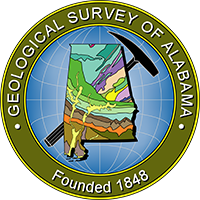

*Click Here for Upper Grades (6-12) Version*
 Investigate Alabama's Waterways
Investigate Alabama's Waterways
|
Distribution of Water on Earth
CK-12 Foundation Click image to enlarge it |
Roughly 70% of Earth's surface is covered with water. 97% of the water on Earth is saltwater, found in oceans and seas. Only 3% is freshwater. Most of that freshwater is found frozen in glaciers, ice caps, or deep underground in aquifers (rock or sediment saturated with water).
Only one-third of that freshwater (or 1% of all water on Earth) is usable by humans to meet our needs. It is found in rivers, lakes, soil, the atmosphere, and within organisms. (see diagram on right) It is replenished by precipitation (rain, sleet, snow).
Alabama is one of the top ranked states for freshwater habitats and resources. Alabama has more stream miles that are able to be sailed on by boat than any other state and is ranked 7th in the country for its amount of stream miles.
Freshwater habitats including rivers, streams, lakes, marshes, bogs, and estuaries (where rivers flow into oceans) provide the state with unique habitats. Alabama's unique geological features and abundant freshwater habitats allow for a high level of biodiversity (the variety of living things in an area) in the state.
| Click on the topics below to learn more! | |||
| Watersheds | Rivers and Streams | Lakes and Ponds | Additional Habitats |
| Watersheds | ||
| What is a watershed? | ||
|
||
| At the highest point, water begins to flow downhill, eventually collecting in streams. These initial streams will join other streams to create a larger stream. These larger streams will eventually connect with major rivers or lakes.
Ground water, water found in spaces between soil particles underground, also moves downwards towards the nearest outlet such as a stream or spring. "We all live and work in a watershed, as all land is part of a watershed. Your everyday actions (work, play, and general living) can impact (positively or negatively) the quality of water that flows from your watershed. As water flows through the system, the impacts are cumulative. This means that everything you do on the land can impact the water that flows to your downstream neighbors. Likewise, everything that landowners above you do impacts the quality and quantity of what flows across your land." (Quote from ACES) |
Diagram of a Watershed
Dreamstime Click image to enlarge it |
|
| Watersheds in Alabama: | ||
Alabama has several smaller watersheds within three broad areas:
|
||
| Learn about your watershed: | ||
| Click here to learn more about specific watersheds in Alabama!
Click here to see how water flows when it lands in a specific location! |
||
| Rivers and Streams | ||
| How is a river formed? |
Stream Order Diagram
Wikimedia – Langlaufer Click image to enlarge it |
|
|
||
|
||
| Stream Habitats: | ||
Different parts of streams and rivers have different characteristics and provide different habitats for aquatic wildlife.
Different aquatic organisms are able to survive in different parts of streams called microhabitats (smaller unique habitat within a larger habitat or ecosystem).
|
Parts of a Stream
Missouri Department of Conservation, Texas Parks and Wildlife Department, The Meadows Center for Water and the Environment, Rudolph Rosen Click image to enlarge it |
|
|
||
|
Floodplain Diagram
flickr – placeuvm Click image to enlarge it |
|
| Alabama Rivers: | ||
The variety of geological features of Alabama leads to a variety of rivers and streams that are noticeably different depending on the location in the state.
|
Cheaha Creek, Cheaha Creek Gorge, Clay Co. AL
photograph by Alan Cressler Click image to enlarge it |
|
Many of Alabama's rivers and streams are known for their high diversity of freshwater fishes and snails. |
Perdido River, Perdido Watershed in the Southeastern Plains Ecoregion
flickr – FWC Fish and Wildlife Research Institute Click image to enlarge it |
|
|
Major Rivers in Alabama
Wikimedia – pfly and John Lambert Click image to enlarge it |
|
SOURCES USED FOR THIS PAGE:
|
|
 |
|
 |
|
|
 |
 |
|
 |
||
Website Design and Digital Marketing by